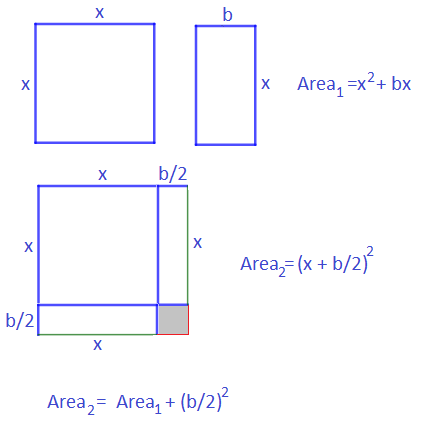Completing the Square
The standard form for a quadratic equation is $y=ax^{2}+bx+c$. The graph of the equation will be a parabola, degenerating into a line when $a=0$. If $a > 0$, the parabola “opens up” and if $a < 0$, it “opens down”. With a little algebra, the equation can be put into vertex form, so called because it is a way of getting the vertex of the parabola. $$y=a\left(x-h\right)^{2}+k$$ $$h=\frac{-b}{2a}$$ $$k=-\frac{b^{2}-4ac}{4a}$$ The values for $h$ and $k$ are the vertex of the parabola. But, this section is not about parabolas. It is about how to rearrange the standard form into the vertex form and about why we might ever want to do that.
Intuitive Understanding
Assume a square and a rectangle. We will assign the square to have side length $x$ and the rectangle to have side lengths $b$ and $x$. If we write an equation for their area we get $x^{2}+bx=Area_{1}$.

Now divide the rectangle in half and move the two halves to line up with the side and bottom of the square. Clearly, this does not change the total area in any way. But it does show that we have formed a larger square, except that our large square is missing a piece. We can write an expression for the area of the larger square. $Area_{2}=(x+b/2)^{2}$
Visually, it is obvious that $Area_{2}=Area_{1}+(b/2)^{2}$.
If we were trying to complete the square for an equation of the type $x^{2}+bx=c$, We would change it to $(x+b/2)^{2}=c+(b/2)^{2}$.
Answer: For a quadratic equation with a single variable, $x$, it means to make one side of the equation a single squared term and to make the other side of the equation a constant. Suppose we have $x^{2}+7x=4$. Then, from the intuition above, $$\left(x+\frac{7}{2}\right)^{2}=4+\left(\frac{7}{2}\right)^{2}$$ $$\left(x+\frac{7}{2}\right)^{2}=\frac{65}{4}.$$ We have not changed the equation! If we multiply it out and then combine terms, it is still $x^2+7x=4$.
So we have seen roughly how to complete the square. In the remaining sections of this topic we will explore a few of the reasons that we might ever want to do this.